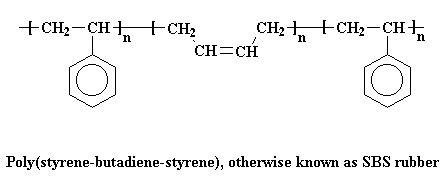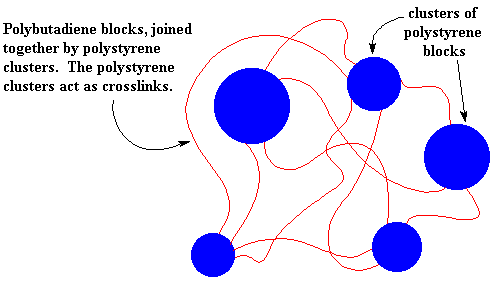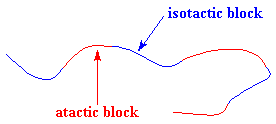
We all know that elastomers are wonderful. Crosslinking makes this all possible. But crosslinked polymers can't be recycled very easily. So in the interests of keeping the earth from becoming a giant landfill, we've come up with a new approach, the thermoplastic elastomer. The idea behind thermoplastic elastomers is the notion of a reversible crosslink.
Normal crosslinked polymers cannot be recycled because they don't melt. They don't melt because the crosslinks tie all the polymer chains together, making it impossible for the material to flow. This is where the reversible crosslink comes in. Normal crosslinks are covalent, chemically bonding the polymer chains together into one molecule. The reversible crosslink uses noncovalent, or secondary interactions between the polymer chains to bind them together. These interaction include hydrogen bonding and ionic bonding.
The beauty of using noncovalent interactions to form crosslinks is that when the material is heated, the crosslinks are broken. This allows the material to be processed, and most importantly, recycled. When it cools again, the crosslinks reform.
Two approaches have been tried, ionomers and block copolymers.
Ionomers
Ionomers are a kind of copolymer. They are copolymers in which a small portion of the repeat units have ionic pendant groups attached to them. Not a lot, now, just a few. Normally the polymer backbone chain will be nonpolar. We all remember the rule, like dissolves like. It works here, too. The nonpolar polymer backbone chains will group together, and the polar ionic pendant groups will cluster together. Now as much as the cluster of ionic groups, snobbish as they are, would like to separate themselves completely from the nonpolar backbone chains, they can't. Remember, they're just sort of attached to the backbone chains. So what ends up happening is that these clusters of ionic groups serve to tie the backbone chains together, just like a normal crosslink would.

Except for one small difference. If we try, just for fun, to heat up these ionomers, something nifty and rather convenient happens. The ionic clusters will break up. When molecules get hot, they move around more. To be sure, this motion of molecules is heat itself. Moving around like this at high temperatures makes it hard for the ionic groups to stay put in their little clusters. So they break up. Now the ionomer has lost its crosslinks, and can be processed and recycled just like an ordinary polymer. Cool it back down, and the ionic clusters form again, and it acts like a crosslinked polymer again. Nifty, huh?
Block Copolymers
We can make a thermoplastic elastomer another way. That other way is called a block copolymer. A copolymer is a polymer made from more than one kind of monomer, that is, made out of two or more comonomers A block copolymer is a copolymer in which the comonomers are separated into long sections of the polymer backbone chain. Each of these sections, called blocks, looks sort of like a homopolymer.

A very common thermoplastic elastomer that is a block copolymer is SBS rubber. SBS stands for styrene-butadiene-styrene, because SBS is made up of a short chain of polystyrene, followed by a long chain of polybutadiene, followed by another short chain of polystyrene. If we could stretch out a chain of SBS, it would look like the picture below.


Being green seems to be easier than certain frogs thought!
But you can also make a thermoplastic elastomer using a block copolymer made form only one kind of monomer! I know that makes no sense, a copolymer with only one kind of monomer, but it's true. You can make polypropylene in which there are blocks of different tacticity. One can make polypropylene with atactic blocks and isotactic blocks using metallocene catalysis polymerization, like this:


Copyright ©2005 Polymer Science Learning Center Department of Polymer Science The University of
Southern Mississippi
refrence of this text is : http://www.pslc.ws/
